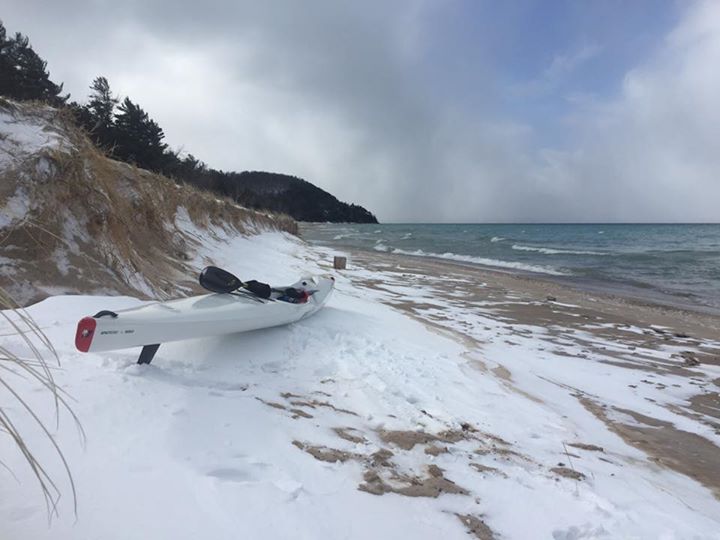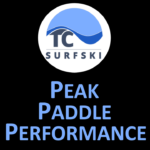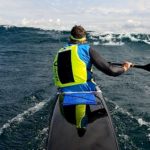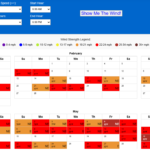Proceed with Caution, Enter at your Own Risk
Although I would like to think that we are almost out of the cold water paddling season in the Great Lakes, the reality is that we still have at least six more weeks with dangerously cold water. This past year I’ve logged more time in cold water than any other year, so I wanted to share my latest experiences and thoughts on how to be prepared and mitigate risks.
First and foremost, I want to be clear that I am not advocating paddling in cold air/water conditions. There are many other enjoyable activities to do in the colder months that are much safer. No matter how prepared you are with all the right skills, gear, and equipment, the fact is that winter/spring paddling is a high risk activity with a very thin margin for error. The key is being honest with your abilities and tolerance for risk. I have now been paddling a surfski for 10 years and have invested considerable time in mastering my brace and remounts, so that results in me choosing to go out on the water almost every weekend through the winter. Below is a recap of my latest thoughts, experience, and gear.
Conditions:
I’ll be the first to admit that I’m addicted to surfing and the minute I see white caps on Lake Michigan (which is almost everyday in winter) I want to be out there. That said, in the middle of winter when the wind chill is down in the single digits (Fahrenheit), I do have boundaries and I won’t go out if the surf looks at all problematic. At my experience level, this equates to anything over 4 foot waves. My concern with the surf zone is that I’ve learned that if you get knocked off either going out or coming it, it can be challenging to remount the ski in the short period wind waves. On warm days, I’ve played around with trying to swim the boat in and that has proven incredibly difficult if not impossible. So while it may seem that you are close to shore and safe, that can be a very false sense of security in cold water, it is not at all uncommon for drownings to occur less than 100 yards from shore.
There is also the concern in cold conditions of the boat icing up to a point that becomes dangerous. Specifically having the rudder lines begin to freeze which would impact control and having the deck/seat freeze and impact stability. This could become very dangerous even in 2-3 foot waves. I have never had the rudder lines freeze up on my V8 but I have heard from paddlers who did experience this. I’ve had icing on the deck, but never in the seat or to a point that it impacted my stability, but again, I have heard stories of this happening.
The Boat
Starting this year I have committed to paddling the Epic V8 from November through April. No questions asked! I’ve now spent 9 years paddling a V10 or V12 regularly in 3-5 foot waves, and have started spending time in an Epic Legacy K1 on flat water, so coming from this reference point, the V8 is quite stable for me. Not only is it very rare that I would ever come off the boat, if I do, my remount is very solid.
I also reign in the distance that I will paddle offshore, in the summer months I’ll often go a couple miles off-shore, but between Nov and April I won’t go further than 1 kilometer and that is also with an on-shore wind. I won’t go out in an off-shore wind.
Gear
The big game changer this year was the purchase of the Immersion Research Microwave Pogies. These have been by far the best $40 purchase I have ever made. A big shout out to the Kayak Shed in Hood River where a passionate employee and white water paddler recommended these. I’d always been reluctant to use Pogies thinking they would be too hard to get my hands in and out of quickly when launching in the surf, doing remounts, or simply needing to grab my phone or other safety equipment. The Immersion Research have a super wide opening that allows your hand to easily slip into them. While this might lead you to think that they wouldn’t be warm, nothing could be further from the truth. They are ridiculously warm. I went out on days when the wind chill was 5 degrees, and my hands were warm within 2-3 minutes. Of course the one caveat is that they are heavy, but this is off-season training so a little extra resistance isn’t so bad.
During the winter months I prefer the Kokatat Meridian as my go to drysuit. I typically wear one layer of tight fitting thermal fleece underneath it, and a pair of NRS 3 mm booties over my feet (The Meridian has built in socks). The Meridian was first recommended to me by Wesley Echols of SurfskiRacing.com, who also does a considerable amount of winter paddling. The beauty of this suit is that it has a neoprene neck which tends to be a lot more comfortable than latex. On the mellow days you can loosen it up a bit for additional comfort.
On my head I wear an NRS Hydorskin Balaklava on the real cold days, or the Vaikobi vCold beanie on milder days (40 degrees and up)
Drysuit versus Wetsuit
There is always a lot of debate and I’ve given considerable thought to whether a wetsuit or drysuit is the better option. I find the drysuit more comfortable and easier to slip into with less resistance while paddling, but I also know very well that it does not make me bulletproof. Paddling a surfski and chasing runs, you will definitely sweat. With a heavy sweat, it won’t take too long in freezing water before hypothermia sets in. Additionally there is always the chance of an unnoticed rip or open zipper which could be fatal. Years of skydiving taught me to be very OCD with my gear, this definitely helps with the drysuit zippers. I know that swimming in a drysuit is not an easy and quick endeavor. So the net/net, worst case scenario, you have to know that if you go into the water, the drysuit will buy some time, maybe 40-50 minutes, but it by no means makes you invincible and you’re going to have a very hard time making a swim of any distance.
I haven’t yet tried paddling in a serious winter wetsuit which would be something like a 5/4 with built in hood, but I have been eyeing the O’Neil Psycho Tech which is said to have amazing flexibility. I do think that with the right thickness of wetsuit, you would be better prepared for a long immersion in the water and/or swim for shore.
I own a Quicksilver 3/2 full wetsuit that was recommended by Oscar Chalupsky, and I like it when the air temps are up in the 60s and 70s but the water is still in the 40s and rough enough that I could go for a swim. Paddling hard in a full wetsuit takes a lot out of you, but again, resistance training when not racing isn’t such a bad thing.
The other option that I like on milder days is the NRS 3.0 mm farmer john. I love this with a Vaikobi base layer underneath and a Mocke Vest over the top. The Farmer John leaves your arms free for unrestricted paddle strokes, while still providing a lot of protection on your core. This makes a good setup in the spring days when the air might be in the high 60s or 70s but the water is still in the low 40s. Which is by far the most deadly and deceiving conditions that claim the most lives in the Great Lakes. This setup is quite comfortable and offers protection for a few spills into the water, but I haven’t tested how long this would protect me sitting in 40 degree water, probably not more than 30-40 minutes as the armpits are exposed
The bottom line is if you are determined to paddle in cold water, buy what you can afford. Typically the wetsuit option is going to be a lot cheaper. The super stretchy ones are expensive, but you can always find basic heavy neoprene for pretty cheap. I know that in Alaska the white water rafting guys typically have clients get decked out in fleece insulating layers with heavy neoprene over the top and splash jackets on top of that. This creates a pretty solid and low cost setup.
Additional gear that I never leave shore without:
- Leg Leash: A leash is absolutely non-negotiable when paddling a surfski. Most paddlers prefer a leg leash over a paddle leash and many go with both when added safety is warranted. An additional and perhaps better option is leashing leashing the shoulder strap of your PFD to the boat. The key is that whatever setup you use, you must practice remounts in real conditions, with that setup. I prefer the Mocke Lifeline leg leash. I’ve put this leash to the test and it has delivered. Very heavy duty, with an excellent quick release mechanism
- PFD: I tend to use the Mocke in the winter when I need the big front pocket to carry a full safety kit, and the Vaikobi in the summer months when I carry minimal extra gear
- Cell Phone: I absolutely never leave shore without a well charged cell phone. I keep my phone in a Lifeproof case and put that inside an Epic Water Proof Cell Phone Case that is attached to my PFD via a lanyard. A cell phone not in the life proof case is still operable through the Epic case, but I just like to have both for double coverage
- Spot GPS: I don’t own one yet, but have one on the way. Not something I ever want to have to use or would ever rely on, but a great last resort life saver
- Waterpoof / flotable VHF Radio: Tethered to your PFD, the VHF radio can be a great option to call in a rescue from other boats that may be in the area, and/or to communicate with the rescue services
- Strobe Light: Critical to be spotted at night. Although you may not plan to be paddling in the dark, when things go wrong, it often becomes the case. A strobe light can be a game changer in getting located
Before you go out:
If at all possible, it is always best to paddle with a buddy. That said, if they are not prepared and qualified, then you are better off going alone. While it is certainly not by choice, I do 99% of my paddling alone. Assisted rescues are tricky business, so the best plan is to always assume you must be self sufficient and never get a false sense of security because you are with someone else. That said, having someone else of equal or greater skill along with you, certainly adds to the safety level.
Regardless of whether you are going alone or with someone, always notify someone on land when you will be back and the more extreme the conditions, the more specific you need to be with the timing. I typically notify my wife down to the 10 minute window of when I expect to be done and sending her a message to confirm.
Remount
You must have an absolutely bullet proof remount before even thinking about going out in a surfski in cold water. This is simply non-negotiable. And remounting in flat water is nothing like remounting in waves. It is also IMPERATIVE that if you do come off your ski, don’t panic rather take the time to get situated upwind of the ski before you remount. This may require ducking under the ski, and or kicking the ski around to position correctly, but it is well worth the effort. Not only is it physically easier to remount from upwind, but putting your back to the wind has a big calming effect on your psyche which at this stage is hugely critical
Brace
You must have a brace on both sides that is well practiced and instinctual. If you have truly done the work to develop your brace, this should prevent you from having to use your remount.
Cold Showers
I’m certain this is the first time you’ll ever read this in a cold water safety discussion, but for various health reasons I’ve started doing cold showers on a regular basis. I highly doubt I do enough to build a materially higher tolerance to hypothermia from cold water immersion, but I do believe that a daily shock of cold water, combined with a trained reaction of sealing my mouth and breathing through my nose, may be of benefit one day when I come off the boat and get hit with ice cold water. The most common mistake is to gasp for air with an open mouth and suck in a mouthful of cold water. This often leads to a spiral of panic which can be hard to recover from.
My routine is to start with a normal warm shower, wash up, and then turn it as cold as it will go for 2-3 minutes. Like all things in health, the science is still evolving, but some of the reported benefits to cold water exposure include: fighting depression, improving the immune system, training the capillaries in your skin, building more healthy brown fat, and draining your lymph system. If I haven’t lost you yet, check out one of the leading proponents of Cold Immersion, Wim Hoff (aka Iceman), who recently has caught the attention of many wellness and performance gurus. One thing I can say for certain, it is quick, easy, simple, and cheap, so you really have nothing to lose.
Summary
Cold paddling is not for everyone, and nor should it be. But for those determined souls who live in the Northern Regions and can’t imagine a month without paddling, it can certainly be done if you’re willing to accept the risk and do everything in your power to keep it safe. I know I have had some magical moments paddling in the dead of winter, and hope to have many more!
Feel free to contact me if you have any questions on any of the gear referenced above or anything else.
Addendum
Below is some e-mail feedback I received from an Upstate New York Kayaker with 40+ years paddling in cold water, I thought it was well worth adding to this blog:
Wetsuits are better for cold water paddling than dry suits. The mobility is much better in the wetsuit, especially when you consider the clothing you must wear under the dry suit to keep warm. You will note that none of the cold water surfers wear dry suits ( well, virtually none). They need maximum arm and shoulder mobility for paddling out through the waves in a prone position. I have been using a 3/2 mm back zip surfers full suit except in the coldest conditions, when I wear a 4/3 mm suit ( that is 4mm in the body and 3mm in the arms and legs). I have never had an issue with freedom of arm, leg, neck or torso mobility in either. In fact, the thicker suit (Ripcurl Flashbomb, a $400+ suit) is more supple than my Ron Jon 3/2 (which cost a lot less). Initially I had a hard time justifying the expenditure in wetsuits, then I did the math. Where I live (upstate New York) I surfski 9 months out of 12 in a wetsuit, because to do otherwise is to risk life. When air temperature gets cold enough to make just the wetsuit inadequate, I put a tightly knit wool sweater OVER the wetsuit and a splash jacket over that.
By making these provisions, I find that I can be in my heavier wetsuit for a two hour workout at 10 degrees F with no discomfort, and I am not particularly resilliant to cold conditions. I do not need to practice in cold showers to achieve this.
Head, hands and feet make up around 40 to 50% of our heat loss on/in the water. While most products indicate a low priority on these areas, it is imperative to get this right, or you will be in danger and never be comfortable. Step 1, buy a good pair of 7mm side zip wetsuit boots with minimal soul. My favorite and best pic for value is Neosport’s boot. The bottoms are thick enough to walk comfortably on sharp rocks and, with bare feet inside, they keep you warm or, at worst, not numb. Step 2, good gloves. I demand dexterity, for a variety of reasons and need to move my grip along the paddle shaft for various extended paddle maneuvers and draw strokes I have learned to use in sea kayaking and still serve me well in the surfski. I have tried no less than a dozen styles and models of gloves and they have all failed me. Finally, I found the Glacier Glove, which is fairly thin neoprene ( so the glove material is not fighting my grip) inside which I wear military wool gloves. I normally wear a XL size, but by buying a 2X Glacier Glove, I have a perfect fit, with the wool Glove inside, without any constriction of blood flow (which many gloves cause), along with a good grip on the paddle. These gloves cost only thirty some dollars and will last around two seasons for the serious paddler. Step 3, head. All the cold water surfers use a wetsuit hood, but I hate them for the restriction and immobility they cause, and they are really not that warm. I learned long ago, when windsurfing in the winter in central New York, to use wool. A tightly knit stocking cap breathes, does not limit mobility of your head and retains most of its thermal insulation when wet and dries fast. The hat needs to be good, tightly knit, not picky, and not baggy. The best I have found is sold by the Sweater Chalet, who you will find on line. They carry an Austrian one that is boiled wool, for around $80. It is worth it!!! This transformed my winter windsurfing and winter surfskiing. I wear a lighter wool stocking cap with ear flappers and a tossel for warmer water and air temperatures. With these measures, my head and neck have never been a heat loss issue, even in full immersion.
Let cable icing determine when you stop taking out your surfski. This is not a small matter. Fabric rudder lines freeze up and make it near impossible to steer your ski. This could prove fatal. Skis with steel rudder cables will tolerate more icing without lockup, but I would still advise avoiding air temperatures much below 32F. Don’t stop paddling, just shift to a kayak without steering cables. Additionally, the sea kayak will keep you warmer with a spray skirt in place.
Watch out for ice. Even small chunks of floating ice (the size of a gallon jug or smaller) can do damage your beautiful composite hull. Plastic (poly) hulls are more tolerant, but still can be damaged.
Watch out for ice flows, especially in the spring, when ice breaks up but remains in islands on the Lake or river. They move around. You may launch from a clear area and come back to an ice blocked shoreline that is impossible to negotiate.
Become informed about water temperature before you even think about cold water paddling. Minimum temperatures are around mid to high 30s. But even in water in the low 50s, you are good for around 15 to 20 minutes without proper cold water apparel before mental function and coordination starts shutting down. The killer are those 60 or 70 degree days when the water is still cold. Places like the great lakes, New York’s finger lakes, etc. are only running in the high 40s in May and the 50s in June, both deadly without proper protection. As it gets warm, dress for water temperature, not air temperature. You will note that even in Santa Cruz ( that’s California), all the surfers wear full surfer’s suits with hoods for their typically 50s water temps. When the air gets too warm, splash water on the wetsuit or get in the water briefly. That always solves it for me. Carry a thermometer in your surfski bag to become familiar with the water temperatures in your area at various times of the year. Hypothermia is very unforgiving.




